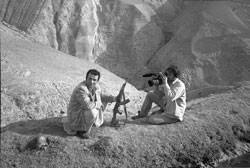By Kaitlen Jay Exum
“All I could think about in response to September 11th was making a documentary film in Afghanistan,” says filmmaker Taran Davies of Wicklow Films on
Lafayette Street. “I had a sense that, at that time, we didn’t have any clue who the Afghans were. It occurred to me that we just thought of them as either refugees or terrorists. I realized that there were still many millions of Afghans who were living devastated but relatively ordinary lives and I wanted to bring home their story.” With this mission in mind, Davies and his producer Walied Osman set off for Afghanistan barely a month after the World Trade Center attack.
The resulting documentary, “Afghan Stories,” provides insightful glimpses into the lives of a variety of Afghans. In Queens—New York—a member of the Afghan royal family tells of being tortured by the Taliban. In Tajikistan—Central Asia—a family of refugees waits for the day when they may be allowed to join their relatives in Canada. In Afghanistan, a respected elder and his soldier son welcome Davies and Osman into their home. And the filmmakers celebrate the construction of a road with a United Nations representative and a local warlord.
Sympathetic without being overly sentimental, “Afghan Stories” depicts its subjects with genuine compassion. Rather than focus on the front lines of the war, the documentary concentrates on those individuals who are “just getting on with their lives” in a country that has been war-torn for 24 years.
Having traveled extensively in central Asia, the Caucuses and Siberia, Davies found the idea of filming in Afghanistan undaunting. Following the September attacks, Davies left his job downtown as an investment banker, dropped his applications to business school and enlisted the help of Afghan-American entrepreneur Osman. As Osman had not been to Afghanistan since the age of seven, he was apprehensive about the reception he would receive, but he and Davies were almost invariably welcomed. Davies says he was never concerned for his safety, and as the documentary shows, he and Osman seem to have been warmly welcomed throughout their experience. “The Afghans are the most extraordinarily hospitable and wonderful people,” Davies repeats.
“It’s interesting, going into a country, as an American, that the Americans are bombing and expecting to be received well. Nevertheless, we were received with open arms wherever we went. Only on a couple of occasions did we find any sort of hostile attitudes, but both were very brief… isolated incidents in a month of being received well wherever we went.”
The film was shot between when the first U.S. bombs were dropped and exactly a day before the first major town fell to the Northern Alliance. Davies describes the time as a “twilight zone period, which, rather than being an aberration, is the norm for this particular region, since for the past 24 years it has always been like this.”
Davies is somewhat concerned that audiences will consider his film irrelevant in light of world-wide attention still focused on Iraq. “Afghanistan is what it always has been,” Davies says. “What you see in “Afghan Stories” continues to be very pertinent to what is actually happening today.”
“Dropping bombs seems to be of more interest to the media and to us than helping to rebuild. If the media looks away, then maybe governments will look away and obligations that have been made to commit finances to helping reconstruct Afghanistan might be forgotten. And that would be just a terrible loss.” However, Davies sees this media silence as an opportunity for further investigation; he hopes to make another documentary to detail the reconstruction effort in Afghanistan.
Afghan Stories, which was filmed during a period of U.S. bombing rather than rebuilding, focuses on a definite trend toward reconstruction.
In one significant scene, the filmmakers are invited to celebrate the completion of a road that was built by the collaborative efforts of a local community, a U.N. World Food Program representative and a warlord. Ironically, recent rain has made the new road muddy, and the filmmakers’ jeep cannot make it up the hill to the end of the road. “I suppose it’s representative of the efforts that are being made to reconstruct Afghanistan,” says Davies. It is a “deep, committed effort,” but, literally in this case, an uphill battle.
The ultimate message of Davies’ film is one of hope. He attests that slow but determined strides are being made in a country that has suffered under the regimes of both the former Soviet Union and the Taliban. Both “the Afghan expat community and the Afghans in general have enormous hope for their country. Hope has been translated into something more material. People are beginning to rebuild. You see this in terms of actual construction taking place again, to people looking after their back yards. In the small and in the big ways, people are beginning to realize that there’s a chance that the destruction is really over.”
“Afghan Stories” will air along with two of Davies’ other documentaries, “Mountain Men and Holy Wars” and “Land Beyond the River” on Sundance Channel as part of the Portraits of Islam series from May 19-21.
For more information, visit www.sundancechannel.com






































